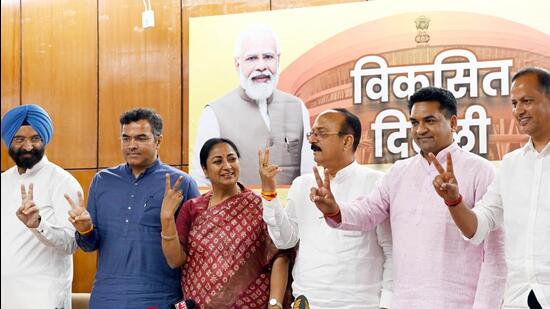Education in Delhi Budget 2025: A Comprehensive Analysis
admin

The Delhi Budget for the fiscal year 2025-26, presented on March 25, 2025, by Chief Minister and Finance Minister Rekha Gupta, marks a significant milestone as the first budget of the Bharatiya Janata Party (BJP)-led government in Delhi in over 26 years. With a total outlay of ₹1 lakh crore—a 31.5% increase from the previous year’s ₹76,000 crore under the Aam Aadmi Party (AAP) government—the budget reflects a shift in priorities while maintaining education as a key focus area. Allocating ₹19,291 crore to education, the budget emphasizes infrastructure development, technological integration, and student empowerment, aligning with the vision of a “Viksit Delhi” (Developed Delhi). This article delves into the specifics of the education allocations, their implications, and how they compare to previous years, while critically examining the broader context.
Key Education Allocations in Delhi Budget 2025-26
The education sector has been granted ₹19,291 crore, constituting approximately 19.29% of the total budget. This represents an increase of ₹2,895 crore from the ₹16,396 crore allocated in the 2024-25 budget, though its share of the total budget has slightly decreased from 21.57% last year due to the overall budget expansion. Below are the standout provisions:
- New CM Shri Schools and National Education Policy (NEP) Alignment
The government has earmarked ₹100 crore for establishing new “CM Shri” schools, modeled after the central government’s PM Shri initiative. These schools aim to integrate the National Education Policy (NEP) 2020’s emphasis on holistic, skill-based education, offering modern facilities and multilingual learning opportunities. - Education Hub in Narela
A significant ₹500 crore has been allocated to develop an education hub spanning 160 acres in Narela, North Delhi. This ambitious project seeks to centralize educational resources, potentially including schools, colleges, and skill development centers, positioning Delhi as a regional leader in education infrastructure. - Technology in Education
- Smart Classrooms: ₹100 crore is dedicated to equipping schools with smart classrooms, enhancing digital learning capabilities.
- Free Laptops: ₹750 crore will fund the distribution of free laptops to 1,200 students passing Class X, aiming to bridge the digital divide and prepare students for a tech-driven future.
- Computer Labs: Plans include establishing 175 new computer labs in government schools, though specific funding details for this initiative were not separately outlined.
- Entrepreneurship and Skill Development
The budget supports entrepreneurial education with provisions for startup support and competitive exam preparation schemes. While exact figures for these programs are not isolated, they fall under the broader education outlay, reflecting a focus on employability and innovation. - Additional Initiatives
- Language labs to promote multilingual education.
- Enhanced teacher training and infrastructure maintenance, though specific amounts remain unspecified in public breakdowns.
Comparison with Previous Budgets
Under the AAP government, education was a flagship sector, consistently receiving over 20% of the budget. In 2024-25, the allocation was ₹16,396 crore (21.57% of ₹76,000 crore), up from ₹16,575 crore in 2023-24 (21% of ₹78,800 crore). The BJP’s 2025-26 budget increases absolute spending but reduces the proportional share to 19.29%, signaling a redistribution of funds toward infrastructure (₹28,000 crore) and water/sanitation (₹9,000 crore). Critics, including Leader of Opposition Atishi, have argued this reflects a diluted focus on education, noting that the AAP had doubled education spending from ₹6,554 crore in 2014-15 to over ₹16,000 crore by 2024-25.
The AAP’s tenure saw initiatives like the Happiness Curriculum, Schools of Specialised Excellence (SoSE), and widespread classroom construction (22,711 new classrooms since 2014-15). The BJP builds on this legacy with its own imprint—CM Shri schools and the Narela hub—while introducing tech-centric measures like laptops, which echo AAP’s earlier tablet distribution to teachers in 2018.
Implications for Delhi’s Education Landscape
- Infrastructure Boost
The Narela education hub and new schools signal a long-term investment in physical infrastructure. If executed effectively, this could decongest existing facilities and cater to Delhi’s growing student population (over 18 lakh in government schools as per past estimates). However, the success hinges on timely implementation, a challenge given historical budget lapses under previous administrations. - Digital Empowerment
The laptop initiative and smart classrooms aim to modernize education, aligning with NEP 2020’s push for technology integration. Yet, with only 1,200 students targeted for laptops, the scale appears limited compared to Delhi’s vast student base, raising questions about equitable access. - Skill Development and Employability
Startup support and competitive exam schemes address India’s youth unemployment crisis (18.4% among educated youth per the ILO’s 2022 report). These align with national priorities outlined in the Union Budget 2025-26, such as the establishment of National Centres of Excellence for Skilling. However, without detailed funding or implementation plans, their impact remains speculative. - Political Context
The budget reflects a BJP narrative of “correcting inefficiencies” from AAP’s tenure, with CM Gupta emphasizing an end to “corruption.” Opposition leaders like Atishi have countered that cuts to health (₹6,874 crore from ₹8,685 crore) and the Municipal Corporation of Delhi (₹6,897 crore from ₹8,423 crore) undermine public services, including education support systems like sanitation in schools.
Critical Examination
While the budget’s education allocations are substantial, several areas warrant scrutiny:
- Proportional Decline: The drop from 21.57% to 19.29% of the budget suggests education is not the top priority it once was, despite the absolute increase. This contrasts with NEP 2020’s recommendation of 6% of GDP for education, a target India (and Delhi) still falls short of—nationally hovering around 4.6% per recent estimates.
- Execution Risks: Past Delhi budgets have seen unspent funds, with critics like the AAP alleging lapses in education spending. The ambitious Narela hub and laptop scheme require robust oversight to avoid similar pitfalls.
- Equity Concerns: The focus on select initiatives (e.g., 1,200 laptops) may not address the needs of Delhi’s underprivileged students comprehensively. The AAP’s broader approach—e.g., free uniforms and books for all—set a higher bar for inclusivity.
- Data Gaps: The absence of the Economic Survey alongside the budget, as highlighted by Atishi, obscures baseline metrics like current enrollment or teacher-student ratios, complicating impact assessment.
Broader Context: National and Regional Trends
Nationally, the Union Budget 2025-26 allocated ₹1.28 trillion to education (a 6.5% increase), with emphasis on AI-driven learning and 75,000 new medical seats. Delhi’s budget mirrors this tech focus but diverges by prioritizing physical infrastructure over higher education expansion (e.g., no mention of new universities beyond the Narela hub). Regionally, Telangana’s ₹23,108 crore education budget for 2025-26 outpaces Delhi’s in absolute terms, though Delhi’s per-student spending remains high due to its smaller population.
Conclusion
The Delhi Budget 2025-26’s education provisions reflect a blend of continuity and change. The ₹19,291 crore allocation, bolstered by initiatives like the Narela hub and free laptops, underscores a commitment to modernizing education and enhancing infrastructure. However, the proportional decline, limited scale of some schemes, and execution uncertainties temper optimism. As the BJP seeks to carve its legacy post-AAP, the budget sets a foundation for a “Viksit Delhi,” but its success will depend on translating funds into tangible outcomes for Delhi’s 2 million-plus students. For now, it’s a promising blueprint awaiting real-world testing.
